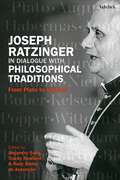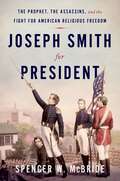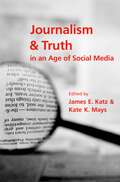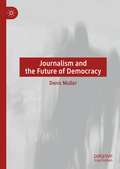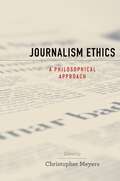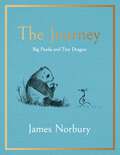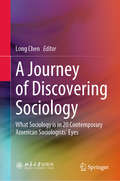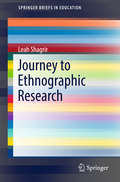- Table View
- List View
Joseph Ratzinger in Dialogue with Philosophical Traditions: From Plato to Vattimo
by Alejandro Sada Tracey Rowland Rudy Albino de AssunçãoThis book extensively explores the various influences and connections between Joseph Ratzinger and a number of leading philosophers; engaging with his work by means of Spanish, Portuguese, German, and English schools of thought through the contributions of a global body of scholars. Each chapter in this volume examines precisely how Ratzinger has dealt with the ideas of a particular philosopher, and how he has appropriated their ideas and thoughts. Moving from philosophers he has modified or critiqued – such as Kant, Comte or Wittgenstein – to those who have contributed to his philosophical theology, such as Guardini and Pieper, this truly international endeavour is an extraordinary journey into Ratzinger's engagement with his competing and congenial schools of thought.
Joseph Ratzinger in Dialogue with Philosophical Traditions: From Plato to Vattimo
This book extensively explores the various influences and connections between Joseph Ratzinger and a number of leading philosophers; engaging with his work by means of Spanish, Portuguese, German, and English schools of thought through the contributions of a global body of scholars. Each chapter in this volume examines precisely how Ratzinger has dealt with the ideas of a particular philosopher, and how he has appropriated their ideas and thoughts. Moving from philosophers he has modified or critiqued – such as Kant, Comte or Wittgenstein – to those who have contributed to his philosophical theology, such as Guardini and Pieper, this truly international endeavour is an extraordinary journey into Ratzinger's engagement with his competing and congenial schools of thought.
Joseph Smith for President: The Prophet, the Assassins, and the Fight for American Religious Freedom
by Spencer W. McBrideBy the election year of 1844, Joseph Smith, the controversial founder of the Church of Jesus Christ of Latter-day Saints, had amassed a national following of some 25,000 believers. Nearly half of them lived in the city of Nauvoo, Illinois, where Smith was not only their religious leader but also the mayor and the commander-in-chief of a militia of some 2,500 men. In less than twenty years, Smith had helped transform the American religious landscape and grown his own political power substantially. Yet the standing of the Mormon people in American society remained unstable. Unable to garner federal protection, and having failed to win the support of former president Martin Van Buren or any of the other candidates in the race, Smith decided to take matters into his own hands, launching his own bid for the presidency. While many scoffed at the notion that Smith could come anywhere close to the White House, others regarded his runand his religionas a threat to the stability of the young nation. Hounded by mobs throughout the campaign, Smith was ultimately killed by onethe first presidential candidate to be assassinated. Though Joseph Smith's run for president is now best rememberedwhen it is remembered at allfor its gruesome end, the renegade campaign was revolutionary. Smith called for the total abolition of slavery, the closure of the country's penitentiaries, and the reestablishment of a national bank to stabilize the economy. But Smith's most important proposal was for an expansion of protections for religious minorities. At a time when the Bill of Rights did not apply to individual states, Smith sought to empower the federal government to protect minorities when states failed to do so. Spencer W. McBride tells the story of Joseph Smith's quixotic but consequential run for the White House and shows how his calls for religious freedom helped to shape the American political system we know today.
Joseph Smith for President: The Prophet, the Assassins, and the Fight for American Religious Freedom
by Spencer W. McBrideBy the election year of 1844, Joseph Smith, the controversial founder of the Church of Jesus Christ of Latter-day Saints, had amassed a national following of some 25,000 believers. Nearly half of them lived in the city of Nauvoo, Illinois, where Smith was not only their religious leader but also the mayor and the commander-in-chief of a militia of some 2,500 men. In less than twenty years, Smith had helped transform the American religious landscape and grown his own political power substantially. Yet the standing of the Mormon people in American society remained unstable. Unable to garner federal protection, and having failed to win the support of former president Martin Van Buren or any of the other candidates in the race, Smith decided to take matters into his own hands, launching his own bid for the presidency. While many scoffed at the notion that Smith could come anywhere close to the White House, others regarded his runand his religionas a threat to the stability of the young nation. Hounded by mobs throughout the campaign, Smith was ultimately killed by onethe first presidential candidate to be assassinated. Though Joseph Smith's run for president is now best rememberedwhen it is remembered at allfor its gruesome end, the renegade campaign was revolutionary. Smith called for the total abolition of slavery, the closure of the country's penitentiaries, and the reestablishment of a national bank to stabilize the economy. But Smith's most important proposal was for an expansion of protections for religious minorities. At a time when the Bill of Rights did not apply to individual states, Smith sought to empower the federal government to protect minorities when states failed to do so. Spencer W. McBride tells the story of Joseph Smith's quixotic but consequential run for the White House and shows how his calls for religious freedom helped to shape the American political system we know today.
Joseph Smith's Translation: The Words and Worlds of Early Mormonism
by Samuel Morris BrownMormonism's founder, Joseph Smith, claimed to have translated ancient scriptures. He dictated an American Bible from metal plates reportedly buried by ancient Jews in a nearby hill, and produced an Egyptian "Book of Abraham" derived from funerary papyri he extracted from a collection of mummies he bought from a traveling showman. In addition, he rewrote sections of the King James Version as a "New Translation" of the Bible. Smith and his followers used the term translation to describe the genesis of these English scriptures, which remain canonical for the Church of Jesus Christ of Latter-day Saints. Whether one believes him or not, the discussion has focused on whether Smith's English texts represent literal translations of extant source documents. On closer inspection, though, Smith's translations are far more metaphysical than linguistic. In Joseph Smith's Translation, Samuel Morris Brown argues that these translations express the mystical power of language and scripture to interconnect people across barriers of space and time, especially in the developing Mormon temple liturgy. He shows that Smith was devoted to an ancient metaphysics--especially the principle of correspondence, the concept of "as above, so below"--that provided an infrastructure for bridging the human and the divine as well as for his textual interpretive projects. Joseph Smith's projects of metaphysical translation place Mormonism at the productive edge of the transitions associated with shifts toward "secular modernity." This transition into modern worldviews intensified, complexly, in nineteenth-century America. The evolving legacies of Reformation and Enlightenment were the sea in which early Mormons swam, says Brown. Smith's translations and the theology that supported them illuminate the power and vulnerability of the Mormon critique of American culture in transition. This complex critique continues to resonate and illuminate to the present day.
Joseph Smith's Translation: The Words and Worlds of Early Mormonism
by Samuel Morris BrownMormonism's founder, Joseph Smith, claimed to have translated ancient scriptures. He dictated an American Bible from metal plates reportedly buried by ancient Jews in a nearby hill, and produced an Egyptian "Book of Abraham" derived from funerary papyri he extracted from a collection of mummies he bought from a traveling showman. In addition, he rewrote sections of the King James Version as a "New Translation" of the Bible. Smith and his followers used the term translation to describe the genesis of these English scriptures, which remain canonical for the Church of Jesus Christ of Latter-day Saints. Whether one believes him or not, the discussion has focused on whether Smith's English texts represent literal translations of extant source documents. On closer inspection, though, Smith's translations are far more metaphysical than linguistic. In Joseph Smith's Translation, Samuel Morris Brown argues that these translations express the mystical power of language and scripture to interconnect people across barriers of space and time, especially in the developing Mormon temple liturgy. He shows that Smith was devoted to an ancient metaphysics--especially the principle of correspondence, the concept of "as above, so below"--that provided an infrastructure for bridging the human and the divine as well as for his textual interpretive projects. Joseph Smith's projects of metaphysical translation place Mormonism at the productive edge of the transitions associated with shifts toward "secular modernity." This transition into modern worldviews intensified, complexly, in nineteenth-century America. The evolving legacies of Reformation and Enlightenment were the sea in which early Mormons swam, says Brown. Smith's translations and the theology that supported them illuminate the power and vulnerability of the Mormon critique of American culture in transition. This complex critique continues to resonate and illuminate to the present day.
Jost Bürgi's Aritmetische und Geometrische Progreß Tabulen: Edition and Commentary (Science Networks. Historical Studies #53)
by Kathleen ClarkThis monograph presents a groundbreaking scholarly treatment of the German mathematician Jost Bürgi’s original work on logarithms, Arithmetische und Geometrische Progreß Tabulen. It provides the first-ever English translation of Bürgi’s text and illuminates his role in the development of the conception of logarithms, for which John Napier is traditionally given priority. High-resolution scans of each page of the his handwritten text are reproduced for the reader and as a means of preserving an important work for which there are very few surviving copies.The book begins with a brief biography of Bürgi to familiarize readers with his life and work, as well as to offer an historical context in which to explore his contributions. The second chapter then describes the extant copies of the Arithmetische und Geometrische Progreß Tabulen, with a detailed description of the copy that is the focus of this book, the 1620 “Graz manuscript”. A complete facsimile of the text is included in the next chapter, along with a corresponding transcription and an English translation; a transcription of a second version of the manuscript (the “Gdansk manuscript”) is included alongside that of the Graz edition so that readers can easily and closely examine the differences between the two. The final chapter considers two important questions about Bürgi’s work, such as who was the copyist of the Graz manuscript and what the relationship is between the Graz and Gdansk versions. Appendices are also included that contain a timeline of Bürgi’s life, the underlying concept of Napier’s construction of logarithms, and scans of all 58 sheets of the tables from Bürgi’s text.Anyone with an appreciation for the history of mathematics will find this book to be an insightful and interesting look at an important and often overlooked work. It will also be a valuable resource for undergraduates taking courses in the history of mathematics, researchers of the history of mathematics, and professors of mathematics education who wish to incorporate historical context into their teaching.
JOURNAL & TRUTH IN AGE OF SOCIAL MEDIA C
by James E. Katz and Kate K. MaysTruth qualities of journalism are under intense scrutiny in today's world. Journalistic scandals have eroded public confidence in mainstream media while pioneering news media compete to satisfy the public's appetite for news. Still worse is the specter of "fake news" that looms over media and political systems that underpin everything from social stability to global governance. This volume aims to illuminate the contentious media landscape to help journalism students, scholars, and professionals understand contemporary conditions and arm them to deal with a spectrum of new developments ranging from technology and politics to best practices. Fake news is among the greatest of these concerns, and can encompass everything from sarcastic or ironic humor to bot-generated, made-up stories. It can also include the pernicious transmission of selected, biased facts, the use of incomplete or misleadingly selective framing of stories, and photographs that editorially convey certain characteristics. This edited volume contextualizes the current "fake news problem." Yet it also offers a larger perspective on what seems to be uniquely modern, computer-driven problems. We must remember that we have lived with the problem of people having to identify, characterize, and communicate the truth about the world around them for millennia. Rather than identify a single culprit for disseminating misinformation, this volume examines how news is perceived and identified, how news is presented to the public, and how the public responds to news. It considers social media's effect on the craft of journalism, as well as the growing role of algorithms, big data, and automatic content-production regimes. As an edited collection, this volume gathers leading scholars in the fields of journalism and communication studies, philosophy, and the social sciences to address critical questions of how we should understand journalism's changing landscape as it relates to fundamental questions about the role of truth and information in society.
Journalism And The Philosophy Of Truth (PDF)
by Jesse Owen Hearns-BranamanThis book bridges a gap between discussions about truth, human understanding, and epistemology in philosophical circles, and debates about objectivity, bias, and truth in journalism. It examines four major philosophical theories in easy to understand terms while maintaining a critical insight which is fundamental to the contemporary study of journalism. The book aims to move forward the discussion of truth in the news media by dissecting commonly used concepts such as bias, objectivity, balance, fairness, in a philosophically-grounded way, drawing on in depth interviews with journalists to explore how journalists talk about truth.
Journalism and the Future of Democracy
by Denis MullerThis book is about how journalism can contribute to the recovery of democracy from the crisis exemplified by the Trump presidency, the Brexit referendum and the rise of populism across the Western world. It explores the ethical concepts that provide the foundation for journalism in modern democracies: pluralism, liberalism, tolerance, truth, free speech, and impartiality. History has shown that crisis brings opportunity for change on a scale that is unachievable under ordinary political conditions, and this book proposes fundamental ways in which journalism can help democratic societies seize the moment. It traces the development of traditional mass media and social media and explores how the two might work better together to benefit democratic life. The development of press theory is described, and enhanced by a proposed new theory, Democratic Revival.
Journalism and the Philosophy of Truth: Beyond Objectivity and Balance (Routledge Research in Journalism)
by Jesse Owen Hearns-BranamanThis book bridges a gap between discussions about truth, human understanding, and epistemology in philosophical circles, and debates about objectivity, bias, and truth in journalism. It examines four major philosophical theories in easy to understand terms while maintaining a critical insight which is fundamental to the contemporary study of journalism. The book aims to move forward the discussion of truth in the news media by dissecting commonly used concepts such as bias, objectivity, balance, fairness, in a philosophically-grounded way, drawing on in depth interviews with journalists to explore how journalists talk about truth.
Journalism and the Philosophy of Truth: Beyond Objectivity and Balance (Routledge Research in Journalism)
by Jesse Owen Hearns-BranamanThis book bridges a gap between discussions about truth, human understanding, and epistemology in philosophical circles, and debates about objectivity, bias, and truth in journalism. It examines four major philosophical theories in easy to understand terms while maintaining a critical insight which is fundamental to the contemporary study of journalism. The book aims to move forward the discussion of truth in the news media by dissecting commonly used concepts such as bias, objectivity, balance, fairness, in a philosophically-grounded way, drawing on in depth interviews with journalists to explore how journalists talk about truth.
Journalism and Truth in an Age of Social Media
Truth qualities of journalism are under intense scrutiny in today's world. Journalistic scandals have eroded public confidence in mainstream media while pioneering news media compete to satisfy the public's appetite for news. Still worse is the specter of "fake news" that looms over media and political systems that underpin everything from social stability to global governance. This volume aims to illuminate the contentious media landscape to help journalism students, scholars, and professionals understand contemporary conditions and arm them to deal with a spectrum of new developments ranging from technology and politics to best practices. Fake news is among the greatest of these concerns, and can encompass everything from sarcastic or ironic humor to bot-generated, made-up stories. It can also include the pernicious transmission of selected, biased facts, the use of incomplete or misleadingly selective framing of stories, and photographs that editorially convey certain characteristics. This edited volume contextualizes the current "fake news problem." Yet it also offers a larger perspective on what seems to be uniquely modern, computer-driven problems. We must remember that we have lived with the problem of people having to identify, characterize, and communicate the truth about the world around them for millennia. Rather than identify a single culprit for disseminating misinformation, this volume examines how news is perceived and identified, how news is presented to the public, and how the public responds to news. It considers social media's effect on the craft of journalism, as well as the growing role of algorithms, big data, and automatic content-production regimes. As an edited collection, this volume gathers leading scholars in the fields of journalism and communication studies, philosophy, and the social sciences to address critical questions of how we should understand journalism's changing landscape as it relates to fundamental questions about the role of truth and information in society.
Journalism Ethics: A Philosophical Approach (Practical and Professional Ethics)
by Christopher MeyersSince the introduction of radio and television news, journalism has gone through multiple transformations, but each time it has been sustained by a commitment to basic values and best practices. Journalism Ethics is a reminder, a defense and an elucidation of core journalistic values, with particular emphasis on the interplay of theory, conceptual analysis and practice. The book begins with a sophisticated model for ethical decision-making, one that connects classical theories with the central purposes of journalism. Top scholars from philosophy, journalism and communications offer essays on such topics as objectivity, privacy, confidentiality, conflict of interest, the history of journalism, online journalism, and the definition of a journalist. The result is a guide to ethically sound and socially justified journalism-in whatever form that practice emerges. Journalism Ethics will appeal to students and teachers of journalism ethics, as well as journalists and practical ethicists in general.
The Journey: A Big Panda and Tiny Dragon Adventure
by James NorburyThe beautifully illustrated new adventure from cherished friends and Sunday Times bestsellers BIG PANDA AND TINY DRAGON'James has a way to speak to your soul. This book is nothing short of comforting and heartwarming' VEX KING'While the drawings have the charm of Winnie-the-Pooh, the captions have the depth of ancient proverbs' GUARDIAN'A beautifully illustrated book which draws on tender moments. Exquisite' DR RANGAN CHATTERJEE__________'We shall go on a journey, across the river . . .'Join Big Panda and Tiny Dragon as they set off on an extraordinary adventure in this companion to the global bestselling phenomenon Big Panda and Tiny Dragon.Although content in their temple high up in the mountains, Tiny Dragon realises that something feels incomplete. So it is that they decide to make a journey together, to new and distant lands.As they encounter dangers and challenges, they learn that everything they need is already inside them and that change, though sometimes scary, is possible and, with patience, can lead to better things.Inspired by Buddhist philosophy and spirituality, the story of these whimsical characters makes the perfect gift for anyone looking for a little hope and comfort.__________'If we have to be lost,' said Big Panda, 'I am glad it is with you . . .'
Journey into Philosophy: An Introduction with Classic and Contemporary Readings
by Stan BaronettThe overriding rationale behind this book is a desire to enrich the lives of college students by introducing them to the practice of philosophical thought in an accessible and engaging manner. The text has over one hundred classical and contemporary readings that facilitate studying each philosophical issue from a variety of perspectives, giving instructors the opportunity to choose a set of readings that matches the individual needs of each class. It includes many selections by philosophers whose works are often ignored or underrepresented in other introductory texts. The initial reading, "The Role of Philosophy," is a relevant, clear, and absorbing introduction to the discipline of philosophy. It uses everyday life situations to give students a solid foothold before they journey into specific philosophical topics. In addition, every section of the book has its own special introduction that connects each topic to students’ personal lives. The surrounding narrative is designed to be conversational and comprehensible. Special features include a section on the role of logic, and writing a philosophy paper, two useful tools for approaching and analyzing philosophical writing for students who are new to philosophy. The book is accompanied by a companion website (www.routledge.com/cw/Baronett), with many helpful features, including (for students) review questions for all readings in the book, videos, and 66 related entries taken from the student-friendly Routledge Encyclopedia of Philosophy and (for instructors) 2,500 questions and answers."
Journey into Philosophy: An Introduction with Classic and Contemporary Readings
by Stan BaronettThe overriding rationale behind this book is a desire to enrich the lives of college students by introducing them to the practice of philosophical thought in an accessible and engaging manner. The text has over one hundred classical and contemporary readings that facilitate studying each philosophical issue from a variety of perspectives, giving instructors the opportunity to choose a set of readings that matches the individual needs of each class. It includes many selections by philosophers whose works are often ignored or underrepresented in other introductory texts. The initial reading, "The Role of Philosophy," is a relevant, clear, and absorbing introduction to the discipline of philosophy. It uses everyday life situations to give students a solid foothold before they journey into specific philosophical topics. In addition, every section of the book has its own special introduction that connects each topic to students’ personal lives. The surrounding narrative is designed to be conversational and comprehensible. Special features include a section on the role of logic, and writing a philosophy paper, two useful tools for approaching and analyzing philosophical writing for students who are new to philosophy. The book is accompanied by a companion website (www.routledge.com/cw/Baronett), with many helpful features, including (for students) review questions for all readings in the book, videos, and 66 related entries taken from the student-friendly Routledge Encyclopedia of Philosophy and (for instructors) 2,500 questions and answers."
A Journey of Discovering Sociology: What Sociology is in 20 Contemporary American Sociologists’ Eyes
by Long ChenThis book gathers the author’s interviews with twenty leading sociologists from various fields at nine different prestigious universities in the USA, including their viewpoints, anecdotes and experiences in the world of sociology. Each chapter presents an interview with one sociologist, covering their views on contemporary sociology, their early university experiences, teaching experiences, experiences with publishing, and their reflections on life as a sociologist.Through the dialogues, readers can learn about sociology as well as sociologists’ lives in a unique and insightful way – just as the author did – and embark on a journey of discovering sociology. The book helps readers find their own answers to the two main questions explored: “What is sociology?” and “What is a sociologist’s life like?”
Journey of no return?: Narrative der Rückkehr im Kontext von Gewalt und Vertreibung im 20. und 21. Jahrhundert (Exil-Kulturen #6)
by Jasmin CentnerDiese literaturwissenschaftliche Studie beschäftigt sich mit Rückkehrerzählungen, denen eine gewaltvolle Vertreibung vorausliegt. Erfahrungen der erzwungenen Entortung und der anschließenden Rückkehr prägen nicht nur die Handlung von Texten, sondern wirken sich auch auf die Ästhetik der Narrationen aus. Die acht untersuchten Erzähltexte (u.a. von Anna Seghers, Abbas Khider, Peter Weiss, Primo Levi, Herta Müller und Doron Rabinovici) befragen (Un-)Möglichkeiten der Rückkehr aus unterschiedlichen Perspektiven. Texte, die vor dem Hintergrund der nationalsozialistischen Vertreibungspolitik entstanden sind, werden mit aktuellen Erzählungen in Verbindung gesetzt. In vier thematischen Sektionen (u.a. Rückkehr aus dem Exil, aus dem Lager sowie nach Palästina/Israel) wird gezeigt, dass die Rückkehr in unterschiedlichen Kontexten ähnliche Erzählmuster hervorbringt sowie Vorstellungen von Heimat und Ursprünglichkeit problematisiert
Journey through Mathematics: Creative Episodes in Its History
by Enrique A. González-VelascoThis book offers an accessible and in-depth look at some of the most important episodes of two thousand years of mathematical history. Beginning with trigonometry and moving on through logarithms, complex numbers, infinite series, and calculus, this book profiles some of the lesser known but crucial contributors to modern day mathematics. It is unique in its use of primary sources as well as its accessibility; a knowledge of first-year calculus is the only prerequisite. But undergraduate and graduate students alike will appreciate this glimpse into the fascinating process of mathematical creation.The history of math is an intercontinental journey, and this book showcases brilliant mathematicians from Greece, Egypt, and India, as well as Europe and the Islamic world. Several of the primary sources have never before been translated into English. Their interpretation is thorough and readable, and offers an excellent background for teachers of high school mathematics as well as anyone interested in the history of math.
Journey to Ethnographic Research (SpringerBriefs in Education)
by Leah ShagrirThis book describes a researcher's journey to carry out an ethnographic study. It serves as a tool to spread the use of ethnographic research, and to clarify the difficulties, challenges, solutions, and advantages ethnographic researchers encounter. The book describes how the various stops along the way allowed investigation of the research area from a variety of viewpoints, in order to fulfil diverse roles, and to present the research findings in a range of voices: the voice of the teacher educator, the voice of the faculty member, the voice of the ethnographic researcher, and the voice of the student. These viewpoints allowed for natural movement between the data that were gathered and the research information that was furnished. Using the voice of each role to present the issue allows one to examine it from a unique perspective and to get a broad and deep picture of the research population, process and results. Such a multi-dimensional perspective enables the presentation of a whole; emphasizing experiences, perceptions, values, world views, rules and regulations, culture and life style, interpersonal and intrapersonal relations.
Journeys in Social Education: A Primer
by Cameron WhiteSocial education is quite a journey. Given the ongoing debate and struggle with “defining” social education, the following is at present a “working definition” - "While we resist ‘defining’ social education, we believe that social education emphasizes three areas of study: critical pedagogy, cultural/media studies, and social studies education. We also stress that education, interpreted broadly, has the potential to advance social justice." Thus emerged social education… a lifelong journey for all of us – to question, to challenge, to do, and to create. Connecting present and past, merging current issues with traditional curriculum, integrating alternative texts and perspectives, empowering and emancipating kids and educators, and transforming schools and society – the transgressions of social education scream out. Dewey, Freire, Kincheloe, Zinn, Greene, Giroux, Apple, hooks, McLaren, Kozol, Loewen, Said, Chomsky, even Bob Dylan and many others have provided the impetus. May we make them proud! The essays within this text demonstrate various journeys in social education. They are meant as stories, not maps or scripts. They are intended to serve as a primer of sorts, for those interested in a similar journey. Hopefully, this can be a meaningful experience for many – students, educators, parents, and society as a whole, of course. Well… the journey and struggle continues…
Journeys in the Mind: On the Origins and Structure of Subjectivity
by Vincenzo SanguinetiThis book presents a systematic exploration of the subjective experience, keeping the investigation for the most part within a subjective first person perspective through the use of “vignettes” as sources of data. It also uses incorporates a ‘"third person” objective approach when that is relevant. The goal of Journeys in the Mind is to capture and convey the operations of the mind: both the shared blueprints common to the elaboration of subjective knowledge as well as the immense fishnet of personalized variables that operate in each mental phase-space and act upon the blueprints to continuously recategorize them into sets of coherent, dynamic outcomes, or mental landscapes. Dr. Sanguineti's meditative perspective holds the promise to enrich the way we understand the workings of the human mind.
Journeys on Screen: Theory, Ethics, Aesthetics
by Louis Bayman Natalia PinazzaAddressing the appeal of the journey narrative from pre-cinema to new media and through documentary, fiction and the spaces between, this collection reveals the journey to be a persistent presence across cinema and in cultural modernity.
Journeys on Screen: Theory, Ethics, Aesthetics
by Louis Bayman Natalia PinazzaAddressing the appeal of the journey narrative from pre-cinema to new media and through documentary, fiction and the spaces between, this collection reveals the journey to be a persistent presence across cinema and in cultural modernity.
